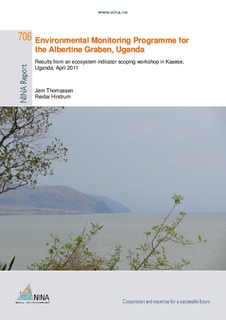| dc.description.abstract | Thomassen, J. & Hindrum, R. 2011. Environmental Monitoring Programme for the Albertine Graben, Uganda. Results from an ecosystem indicator scoping workshop in Kasese, Uganda, April 2011. - NINA Report 706. 118 pp.
Uganda plan to start oil and gas exploration and development in the Albertine Graben in the Rift Valley. The area is a global biodiversity hot spot, and the oil and gas development activities can potentially have severe impacts on the ecosystem and the society. As part of management actions in connection with the planned activities, Uganda will establish an environmental monitoring programme in the Albertine Graben covering ecological and societal issues. Funded by the Norwegian Government under the environment pillar of the Uganda oil for development program, a participatory process has been initiated to build up a monitoring program with indicators. One important step in this process was to arrange a scoping workshop attended by various major stakeholders. The workshop was conducted in Kasese, Uganda from 11th to 14th April 2011. The Norwegian Institute for Nature Research (NINA) was contracted by the Directorate for Nature Management, Norway, to facilitate the workshop. The National Environment Management Authority (NEMA) in Uganda is the lead agency in developing and managing the monitoring program, including the process of establishing it. The main objectives of the Kasese scoping workshop was to identify focused measurable indicators to be used in the environmental monitoring programme for the Albertine Graben. This report summarizes the process at and the results from the Kasese workshop. Several lectures were given to clarify the oil and gas development plans, the status of the biodiversity and sensitivity in the Albertine Graben and the workshop process (see appendix). The Adaptive Environmental Assessment and Management (AEAM) method was used as a working approach to the scoping. The AEAM is a systematic step by step scoping process where the participants work in groups identifying and prioritizing main focal issues (Valued Ecosystem Components (VECs)), the major associated drivers (impact factors from the oil and gas development), cause–effect charts where VECs and drivers are seen in a context, impact hypotheses, and monitoring recommendations including measurable indicators. Five major themes were identified prior to the workshop, namely 1. Aquatic ecological issues: 2. Terrestrial ecological issues; 3. Physical/chemical issues; 4. Society issues; and 5. Management and business issues. A total of 42 VECs and 78 drivers were identified, 31 cause – effect charts were constructed and 46 Indicator Fact Sheets were produced at the workshop. According to the workshop results the ecosystem indicators will be concentrated around wetlands and water, fish, flagship mammals and birds, flagship wetland animal species and flagship floral ecosystem components. Focus was also put on indicators on diversity below ground, physical and chemical indicators on water, air, soil and micro climate. Society indicator recommendations include settlements, food, water and sanitation, health, energy, infrastructure, education, culture and archeological sites. Recommendations concerning management and business issues were given on tourism, fisheries, agriculture and forestry, transport and construction materials. | nb_NO |
